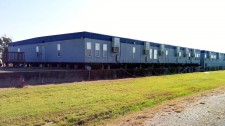Baton Rouge Offered Mobile Flood Recovery Shelters

BATON ROUGE, LA, August 19, 2016 (Newswire.com) - HSTL Modular (www.hstlmodular.com), a nationwide provider of new and used modular buildings and office complexes, reports that it has low-cost private mobile shelter buildings ready for immediate delivery to Baton Rouge, Louisiana, to help flood victims start their recovery process as soon as possible.
Many of the modular buildings were originally used as school and administrative facilities, and come equipped with air conditioning and bathrooms. They feature a range of floor plans making them suitable for use as community disaster recovery centers, offices, classrooms, temporary short-term shelters, and rapid-response health clinics for large populations.
During the short term recovery stage, temporary space is central to functions dealing with impact area security, temporary shelter and housing, infrastructure restoration, business continuity, debris management, emergency demolition, repair permitting, donations management, and disaster assistance.
HSTL Modular
HSTL emergency modular buildings can be delivered, installed, and made move-in ready in 1 or 2 days for smaller units, and less than a week for large complexes.
The largest modular building currently available is 8,400 square feet and may be familiar to some Baton Rouge young adults. (See: http://hstlmodular.com/properties/120-x-70-2006-design-space-10-plex-modular-building-school-complex/) The 10-piece modular complex was manufactured in 2006 by Design Space in Georgia and was used as a school by the Federal Emergency Management Agency (FEMA) in Baton Rouge to handle the children of displaced families who moved north from New Orleans after Hurricane Katrina.
The building is delivered in 10 sections, each measuring 12 feet by 70 feet and tightly assembled to house over 20 connected interior spaces large and small. Each section includes a Bard 5-ton wall-mounted air conditioning unit.
Once assembled, a double-door main entrance opens to a 36-foot main hallway with the staff section of the building on the right, the meeting center on the left, and the administrative center straight ahead.
The administrative center has a reception area, 4 offices, and an ADA-compliant private restroom. The staff section has a large event space (over 1,100 square feet, with cabinets and a serving counter), 8 offices, a conference room, a work room, an I/T room, an ADA-compliant restroom, and a side exit. The meeting center has 3 large rooms (roughly 700 square feet each and one with lockers), a multi-stall ADA-compliant restroom for women, another multi-stall ADA-compliant restroom for men, and a side exit originally designed to connect to another building.
HSTL emergency modular buildings and HSTL recovery experts help disaster victims address four community disaster recovery questions of greatest concern to emergency managers:
First, are the communities likely to recover from a disaster and, if so, how do they acquire the resources needed to replace those that were destroyed?
Second, what happens to households, businesses, and government agencies as they struggle to recover?
Third, what can communities do to promote a more rapid, complete, and equitable recovery?
And fourth, what can communities do to reduce their hazard exposure and make themselves more resilient when extreme environmental events occur?
HSTL Modular relocatable buildings and portable offices support disaster recovery functions at all stages of recovery -- to save homes and keep businesses up-and-running.
During the disaster assessment stage, HSTL Modular facilities are ready to be first on the scene for expedited assessment, preliminary damage assessment, site assessment, victims' needs assessments, and local recovery meetings to review lessons learned.
Next, during the short term recovery stage, temporary space is central to functions dealing with impact area security, temporary shelter and housing, infrastructure restoration, business continuity, debris management, emergency demolition, repair permitting, donations management, and disaster assistance.
Long term reconstruction is the next stage, focusing on hazard source control and area protection, land use practices, building construction practices, public health and mental health recovery, economic development, infrastructure resilience, historic preservation, environmental recovery, and disaster memorialization. Those in charge of these issues can benefit from the availability of temporary space throughout the community.
In addition, recovery management is an overarching set of functions dealing with agency notification and mobilization, mobilization of all recovery facilities and equipment, internal direction and control, external coordination, public information, recovery legal authority and financing, administration and logistical support, and documentation. HSTL Modular move-in ready backup sites make it possible to immediately set up a networked recovery operation.
For more information on ordering or reserving a private mobile shelter, contact Tashi Simmons at 225-283-8411, or email him at tashi@hstlmodular.com.
Contact:
Tashi Simmons
Louisiana Mobile Recovery Shelters
HSTL Modular
www.hstlmodular.com
225-283-8411
1-800-583-HSTL (4785)
tashi@hstlmodular.com
Source: HSTL Modular
